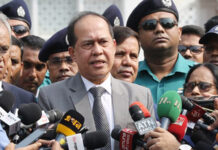Project to ease Dhaka's traffic; BGMEA building illegally stays in the lake
The much-hyped Hatirjheel-Begunbari integrated development scheme in the capital opens to public today.
Prime Minister Sheikh Hasina is scheduled to formally inaugurate the site, despite the fact that the 15-storey illegal building of Bangladesh Garment Manufacturers and Exporters Association (BGMEA) stands boldly in the middle of the Begunbari canal.
The public facilities developed under the development scheme include a 9-kilometre east-west connecting express road, 8km service roads, 477-metre bridges, 9km footpath, 10km lakeside walkway, 260-metre viaduct, 400-metre overpass, an integrated drainage management connecting Begunbari canal with the Gulshan-Banani lakes, a sewer network, an aesthetic public space, and waterfronts. The scheme is also designed to help ground water percolation.
The 302-acre site stretches between Airport Road and Rampura along Tejgaon, Gulshan, Modhubagh, Moghbazar, Badda and Ulan. The project area included 46 acres of Rajuk's land, 34 acres of other government agencies, 81 acres of Court of Wards and 141 acres of private land.
The facilities here also include a theatre, viewing deck, landscaping, and park furniture and a police box. However, construction of the theatre, park and the garden is yet to be finished.
Except for some beautifications and two U-loops, most of the project works have been accomplished.
The U-loops were incorporated in the revised draft project proposal, which is now being implemented in Badda and Rampura to avoid traffic congestion at the Hatirjheel-Rampura intersection.
Commuters from Rampura, Badda, Ulan, Modhubagh, Moghbazar, Gulshan, and Tejgaon would have easy movement in the said areas with the scheme's service roads.
Three bridges have been built across the Hatirjheel Lake along with three viaducts along the peripheral road and four overpasses on the road. Each of them is more than 15 feet high.
An apartment complex with two 15-storey buildings has been developed within the project area to rehabilitate the land owners who had been “genuinely” affected by the scheme.
The Rajdhani Unnayan Kartripakkha (Rajuk), Dhaka Wasa and local government engineering department along with an army engineering corps implemented different components of the scheme since 2008. Bangladesh University of Engineering and Technology was employed as consultant.
Rajuk had to fight a total of 78 land-related cases and 20 contempt charges during implementation period.
One major objective of the scheme is to serve with a storm drainage system to prevent floods in the capital.
Iqbal Habib, architectural consultant of the Hatirjheel-Begunbari integrated development scheme, said the BGMEA building had stood in the way of one of the scheme's main objectives — draining out storm water of four Wasa zones to save Paribagh, Karwan Bazar and Eskaton from flooding.
“We have informed the prime minister of the building being illegal and how it is harming the project,” said Iqbal, adding, “We have tried our best to convince the government.”
Professor Mujibur Rahman, who led the technical expert team of the scheme, said the Begunbari canal stretching from airport road to Rampura and beyond is a vital drainage system to prevent urban flooding.
It is unfathomable why the government had kept from pursuing the legal battle to remove the building and free the canal, Prof Rahman added.
The Dhaka Metropolitan Development Plan (DMDP) earmarks the Begunbari canal as a natural water body and a designated flood flow zone, prohibiting any change to its character.
The High Court in April 2011 declared the BGMEA building illegal and asked the government to remove it in three months and restore the canal to its earlier state.
In response, the BGMEA appealed with the Supreme Court that stayed the order for six weeks. As final hearing of the case has been pending with the appellate division, the High Court order is considered as stayed.
Shafiul Islam Mohiuddin, president of BGMEA, said, “We will go on with the legal battle to save the building.”
Asked what the government has done for the disposal of the appeal, Rajuk Chairman Md Nurul Huda said they had requested the attorney general and hired a private counsel to get the appeal heard.
Various environmental and civic bodies have also time and again demanded that the government take steps to demolish the BGMEA building.
Abdul Mannan Khan, state minister for housing and public works, hoped that the BGMEA authorities would come to senses and take steps to knock the building down.
Prime Minister Sheikh Hasina during her first tenure laid the foundation stone of the BGMEA building in November 1998 while another premier Khaleda Zia inaugurated the building in October 2006.
Rajuk issued land use clearance while Department of Environment environmental clearance and Dhaka Wasa clearance for the building in the canal. Civil Aviation Authorities also issued the height clearance.
BGMEA with various clearances was required to obtain building approval from Rajuk, which it did not do. Rajuk only served a notice on BGMEA in the last eight years of the building's existence.
Source: The Daily Star










